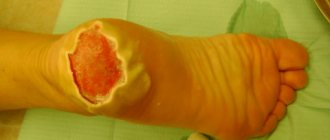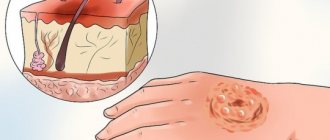Last update: 02/21/2021
The most common burns are household burns, for example, burns from electricity, boiling water and, of course, burns from chemicals and acid. An acid burn occurs when certain chemicals come into contact with the skin or mucous membranes. Chemical burns of acid to the skin of the face, hands, esophagus, larynx, eyes, and groin area are considered especially dangerous.
Causes of sulfuric acid burns
Sulfuric acid is a potent substance that can penetrate into the deep layers of the epidermis. Chemical burns often occur in industrial plants. It is used to purify petroleum products. In the chemical industry, it is used for the production of dyes and fibers, the production of fertilizers, leather dressing, etc. In the domestic sphere, sulfuric acid is used by car owners to prepare electrolyte for batteries.
There are several types of sulfuric acid with different percentages:
- concentrated - 98%;
- tower - 75%;
- battery - 30%;
- diluted (sulphurous) - 10%.
Depending on what type is used, the depth of exposure of the chemical depends. The main causes of acid burns are:
- failure to comply with safety regulations;
- work injuries;
- casual contact in everyday life;
- unprofessional use in cosmetology.
Sulfuric acid
Most often, injuries are local in nature, i.e. a small area of skin is affected. Working with a toxic substance can lead to poisoning by its vapors - internal burns. If acid gets into your eyes, it can have the most dire consequences.
La-Cri products and their assistance in wound healing
After the healing process begins, you can begin the gradual use of emollient creams and La-Cri emulsions. Of course, they cannot be regarded as a complete remedy for acid burns, but they can have a moisturizing, restorative and soothing effect on the damaged area of the skin.
Developed on the basis of natural non-hormonal components and free of parabens, fragrances and silicones, La-Cri products provide gentle care for regenerating skin. They help relieve itching and provide sufficient nutrition to damaged skin areas.
Degrees of burn and type of burn
The degree of exposure to sulfuric acid depends on its concentration, the time of exposure to the skin, the depth of penetration and timely provision of assistance to the victim. There are four stages of chemical injury.
- In the first stage, only the upper layer of the epithelium is affected. After providing first aid and removing acid from the body, skin hyperemia appears, which disappears after a few days without drug treatment. Sometimes a burning sensation and itching may occur.
- In the second stage, the skin becomes blistered and swollen. The acid penetrates into the deeper subcutaneous layers, the patient feels a strong burning sensation. Timely assistance provided leads to a favorable outcome, without scarring.
- The third stage is characterized by blistering of the affected area with a cloudy liquid inside, sometimes with blood. The acid penetrated deep into all layers of the skin, including the fat layer. The patient experiences a painful shock and his temperature rises. The affected area turns red, then quickly darkens, and tissue necrosis is observed. The third stage is treated only in a hospital setting.
- At the fourth stage, the chemical penetrates through all layers of the epidermis, affecting tendons and bone tissue. Even with timely medical care, the prognosis can be unfavorable, even death.
Important: Electrical burn: types and features of treatment
Superficial burn with sulfuric acid
There are also types of chemical burns: superficial, when the external parts of the body are affected, vapor poisoning - the poison enters the internal organs and eye burns. The latter is considered the most dangerous, because it is impossible to determine the depth of penetration of the chemical and correctly assess the scale of the damage.
It is believed that the lethal dose of sulfuric acid ingested is 5 mg.
Survival prognosis
The severity of the injury is determined by the concentration of the reagent and the location of the burn. The healing prognosis is determined by the rule of hundreds - the percentage of the burn area in relation to the remaining tissues is summed up with the age of the victim:
- less than 60 – favorable;
- up to 80 – relatively favorable;
- up to 100 – doubtful;
- more than 100 – unfavorable.
The prognosis for recovery depends on the location of the burn wounds and the depth of penetration of the reagent. The outcome of chemical injury worsens with burn shock and intoxication. Burns with concentrated acids are accompanied by prolonged inflammation. During healing, a lot of granulation tissue forms in the lesions. Therefore, burnt people develop noticeable scars that limit joint mobility.
Symptoms of a burn with sulfuric acid
A slight effect of a weak acid solution on the skin is manifested by slight redness with a light crust around the edges. If the substance is not removed in time, bubbles may form. At first, the damaged epidermis will be whitish, then the skin will darken to a gray or brown tint.
The symptoms of a chemical burn with sulfuric acid differ from ordinary thermal injury and depend on the location of the substance.
Skin burns
Sulfuric acid can get on your body, face or limbs. The person begins to feel a strong burning and itching sensation. A thick crust appears, under which chemicals continue to act on the skin. After the wound heals, a purple scar and deformed tissue remain on the skin.
If measures are not taken, tissue necrosis occurs, regeneration of the damaged area does not occur and the limb has to be amputated. The main symptoms of an acid burn include:
- the upper layer of the epithelium peels off;
- the affected area swells;
- a white scab with clear edges appears;
- darkening of the burned area;
- formation of coagulation type necrosis.
The patient feels severe pain, and in the case of severe damage on a large scale, death occurs.
Burns of internal organs
Sulfuric acid entering the body causes more serious consequences. Vapor poisoning can occur in the area of the larynx, esophagus, stomach, and lungs. Inside the body, sulfur vapors turn into liquid substances containing the acid itself and arsenic. Symptoms of vapor poisoning are as follows:
- swelling of the mucous membranes;
- nosebleeds;
- wheezing, sore throat;
- chest cramps
- attacks of suffocation;
- severe pain and swelling in the digestive organs.
If internal organs are burned by sulfuric acid, a sore throat may occur.
Ingestion of acid in liquid form is accompanied by the following symptoms:
- severe spasmodic pain in all digestive organs;
- vomiting with blood;
- increased salivation;
- stomach upset;
- kidney damage and bright red urine;
- bluish skin;
- disruptions in the functioning of the cardiovascular system;
- dark spots on teeth;
- lips acquire a black-blue tint;
- swelling of the larynx to the point of suffocation.
Subsequently, after suffering a chemical burn to internal organs, a person may develop laryngitis, pharyngitis, pneumonia, etc.
Eye burn from sulfuric acid
The most dangerous condition is the contact of a toxic substance with the mucous membrane of the eyes. Immediately after the acid interacts with the eye, a person begins to feel a strong burning sensation, sharp pain, and profuse lacrimation appears. Bright light causes pain. Further development of the disease is accompanied by the following symptoms:
- vision decreases;
- pallor and cloudiness of the eye cornea;
- swelling of the conjunctiva;
- intraocular pressure increases;
- redness of the eyelid followed by scar formation.
A deep burn leads to complete loss of vision, even despite timely medical assistance.
Consequences
Note! In the absence of timely intervention, the following complications are possible:
- Chronic conjunctivitis is a non-infectious inflammation of the mucous membrane of the eye.
- Keratitis is an inflammation of the cornea with partial blurring of vision.
- Blepharitis is a chronic and difficult-to-treat inflammation of the eyelid margins.
- Cataract is partial or complete clouding of the lens of the eye.
- Glaucoma is a dangerous pathology characterized by increased intraocular pressure and the development of optic disc pathology.
- Corneal ulcer - numerous small ulcers form on the cornea of the eye, which cause discomfort and reduce visual acuity.
In extreme cases, complete atrophy of the eyeball and 100% loss of vision are possible.
First aid for sulfuric acid burns
In case of a burn with sulfuric acid, first aid should be provided immediately. The first thing to do in such a situation is to eliminate the original source of the burn. Further actions depend on the location of the damage.
Important: Using oil for sunburn
First aid for skin burns
If the chemical comes into contact with the body, the victim's clothing should be removed to avoid spreading the affected area. The wound is washed with running water for at least 15-20 minutes until all the acid is eliminated. Do not use cloth or napkins for washing, as... fibers from them can get into the wound and subsequently cause inflammation.
Next, the wound is treated with a soda solution. To do this, dissolve a teaspoon of soda in a glass of warm water and wash the wound well with the resulting mixture. If there is no soda, a weak solution of potassium permanganate or soap foam will do. After this, medications are used in the form of ointments, creams or aerosols: Levomekol, Panthenol, Apollo, Povidone-iodine, etc.
A burn with sulfuric acid can be treated with Levomekol
The treated area is covered with a sterile bandage or gauze. You can buy ready-made antiseptic wipes soaked in medicine at the pharmacy. You can relieve pain with any analgesic.
After first aid is provided, the patient is taken to the hospital, where the doctor can assess the extent of the damage and prescribe appropriate treatment.
Help with burns of internal organs
Acid contact with internal organs is extremely dangerous. The severity is assessed by the concentration and amount of the chemical substance ingested. The patient needs immediate first aid.
- The victim's stomach is washed. You can drink magnesium.
- Rinse the mouth with soda solution.
- The patient is given to drink as much water as possible.
- In case of severe vomiting, the drink should be warm to reduce the effect of the reagents.
After these manipulations, the patient should be taken to the hospital as quickly as possible.
First aid for burns to the mucous membrane of the eye
What to do if the mucous membranes of the eyes are burned by sulfuric acid. The first thing you need to do right away is rinse it with plenty of water. After the substance is completely removed from the mucous membrane, it is necessary to drip the eye with novocaine 2% to eliminate pain or dicaine 0.5%. Further treatment is carried out in a hospital, after examination by an ophthalmologist.
The first thing to do if you burn your eyes with sulfuric acid is to rinse your eyes.
Drug LSD
LSD is a semi-synthetic drug that has a strong effect on the human brain. The psychedelic drug is quite popular among young people around the world. With a single or systematic use of a psychotropic drug, a person experiences a state that can be described as a “journey” to another reality.
Psychological dependence on the drug occurs from the first use. Irreversible mental disorders develop after 1-2 months. Most lovers of this drug become permanent patients in psychiatric hospitals.
A common cause of death from this drug is suicide and accidents due to the effects of LSD on the brain.
HOW TO MOTIVATE A DEPENDENT FOR TREATMENT
What is LSD?
LSD is lysergic acid diethylamide. LSD was first synthesized at the beginning of the last century by Albert Hofmann, a scientist from Switzerland. Diethylamide was the 25th substance obtained during experiments with acid.
Therefore, acid in slang among consumers was called “twenty-fifth.” The drug has several slang names: lizer, laser, microdot, square, sour, acid.
What is Bicycle Day?
As a result of his experiments, chemist Albert Hofmann injected himself with an aqueous solution of LSD, after which he was unable to continue working. It became difficult for him to express thoughts, his perception of reality was distorted, visual disturbances and dizziness appeared.
The scientist was unable to continue his work and rode home on a bicycle, where his family called a doctor. By the time the doctor arrived, the effects had already disappeared. The chemist described in detail his sensations and effects from LSD. Thus, the day of the important discovery became known as Bicycle Day.
Composition of LSD
The LSD molecule is made up of carbon atoms. The atoms in the molecule are arranged asymmetrically, resulting in the formation of 4 stereoisomers, and only one of them, diethylamide, has psychoactive properties.
Photo of the drug: what it looks like
Effect of LSD
The narcotic effect of LSD is a strong change in the perception of reality, mood and other processes of the human body. Scientists still cannot say with certainty how the drug affects humans. Some argue that psychosis and schizophrenia can be cured with the help of LSD, while others claim that the drug will only worsen a person’s mental state.
A narcotic substance with a lysergic acid derivative, according to most scientists, is an analogue of important brain neurotransmitters:
- Serotonin . Known as the hormone of joy and happiness. Serotonin takes part in the formation of a feeling of pleasure and causes the effect of euphoria. Excessive levels of serotonin can cause hallucinations.
- Dopamine . Participates in the functioning of brain functions such as concentration, memory, speech and thinking. Dopamine helps improve mood.
- Adrenaline and norepinephrine . Helps activate the motor functions of the body. Stress hormones increase nervous arousal, increase heart rate and blood pressure.
The psychedelic has a strong effect on the emotional state and physiological processes in the body. The effects of lysergic acid are expressed in the appearance of the following main symptoms:
- The appearance of insomnia;
- Confused speech;
- After a dose of the drug, nausea and vomiting may occur;
- Feeling of increased body temperature;
- Pupils dilate;
- The emergence of feelings of anxiety, panic attacks;
- Changing the perception of reality;
- Emotional experiences, including those of a religious nature;
In addition, those who use LSD often experience auditory and visual hallucinations, and their mood often changes dramatically. The sense of reality of what is happening is lost.
Find out treatment recommendations without leaving home for free
To select a treatment plan, you just need to leave a request, we will contact you to select the time and specialist you need
Submit your application
Duration of action of LSD
The period of exposure to a dangerous drug depends on the individual characteristics of the person, his body weight, metabolic rate and the amount of the drug taken. Usually the drug acts on the body from 6 to 12 hours, but residual effects can be observed for several days after use.
Diagnosis of burns after sulfuric acid
Symptoms of a burn with sulfuric acid are similar to burns caused by other chemicals, therefore, to make a correct diagnosis, the doctor carries out diagnostic measures:
- visual inspection. If acid gets on the skin, study the location of the burn, the depth of penetration, and the stage of the disease;
- radiology diagnostics. It is carried out in case of acid ingress. Using radiography, the extent of the lesion is assessed and perforation of the stomach and esophagus is detected. Computed tomography allows you to determine damage to hollow organs;
- laboratory research. In case of acid vapor burns, the patient's blood pH is measured, a urine test is prescribed, and blood is taken to determine the level of hemoglobin, coagulability, and the concentration of electrolytes in the plasma.
Burns of sulfuric acid to internal organs are similar to other diseases and in order to distinguish them, differential diagnostics are carried out. The burn is separated from infectious diseases, allergic esophagitis and spontaneous ruptures of the esophagus. To do this, an endoscopy is performed within the next 24 hours. This period is safe for such examination. During the examination, the doctor reveals perforation of the esophagus, severe necrosis of the stomach, duodenum, etc. With the help of endoscopy, it is possible to make the correct diagnosis. Skin burns do not require differentiation. The doctor visually determines the substance that has come into contact with the skin, the stage of the disease and the volume of damaged surfaces.
Important: Burn scars: how to get rid of them forever and is it real?
Experts' opinion
Clinical studies conducted with the participation of the Union of Pediatricians of Russia made it possible to establish that:
- When using the complex of products, the level of skin moisture decreased by 4% in comparison, and in the group that used Placebo, the level of moisture decreased by 9%.
- When using the complex of products, the level of skin acidity increased by 1% in comparison, and in the group using Placebo, the acidity level decreased by 1%, while in the second group of subjects the initial value of skin acidity was significantly higher.
- Skin moisture levels decreased slightly and remained in the dehydration zone, however, when used, the indicators remained significantly better than those of the group using Placebo. The level of sebum in general was initially low, and as a result, in the group that used alternative skin care products, it decreased by almost 2 times, and in the group that used it remained at the same level.
- When assessing the dynamics of the epidermal barrier indicators using the EASI diagnostic scale, in the group of patients who used the product, the average percentage of improvement when completing the full course was 28% and only 9% of patients remained unchanged, while in the group who used “Placebo”, 13% of patients showed improvement and 56% of patients without change.
Sources:
- Ratner Desiri, Avram M.R., Avram M.M., Procedures in Dermatology. Clinical cosmetology, Publishing house: GEOTAR-Media, 2019
- Sukolin Gennady Ivanovich, Clinical dermatology. A short guide to the diagnosis and treatment of dermatoses, publishing house: Notabene, 2017
- Schneiderman Paul, Grossman Mark, Differential diagnosis in dermatology. Atlas, Publishing house: Binom, 2017
Methods for treating burns with sulfuric acid
A person who has been burned by sulfuric acid needs long-term and complex treatment. It is carried out by a combusiologist. The main goal is to reduce the level of discomfort and restore damaged tissue. Treatment is carried out according to the following scheme and includes:
- pain relief with tablets, and in cases of severe damage, drugs are administered intravenously;
- healing with Sudocrem, Panthenol, Solcoseryl;
- vitamins to accelerate tissue regeneration;
- physiotherapy. Prescribed at the stage of epithelization of the wound surface.
In case of serious burns, the doctor takes measures to support the vital functions of the body and prevent the development of complications. The patient is advised to perform small passive exercises that will help maintain muscle mass.
Treatment for skin damage
Treatment of skin burns begins with the removal of the reagent. When the acid hits the skin, it forms a soft white crust on it. To dry the burn, alcohol-free silver-based preparations and iodine solution are used. It is mandatory to use medications that regenerate and improve blood circulation: Baneocin, Actovegin, Solcoseryl. The choice of drug depends on the degree and depth of the lesion.
Sulfuric acid burns can be treated with Baneocin
Treatment of internal organs
Internal chemical burns are treated only in a hospital under the supervision of a doctor. Therapy includes taking painkillers and sedatives, eliminating spasms and pain shock. Measures are being taken to prevent the formation of scars and normalize the functioning of internal organs. The patient is also prescribed a course of antibiotics to prevent the occurrence of a secondary infection.
Treatment of burns of the mucous membrane of the eyes
A chemical burn to the eyes requires a professional approach, otherwise the person may lose his sight. For better interaction between the doctor and the patient, the latter is injected with an anesthetic. Steroids are used to prevent tissue necrosis. They help slow down the inflammatory process.
Ascorbic acid performs an important task in restoring collagen structure and leads to corneal restoration. Sometimes the patient is prescribed to wear bandage contact lenses until epithelialization is completed.
If the situation is extremely difficult, surgery may be necessary. The doctor removes the affected areas of the conjunctiva or the upper portions of the cornea.
How much LSD leaves the body
Lysergic acid is an almost elusive type of drug. It does not linger in the body and is eliminated naturally very quickly. This is why tests and laboratory tests often do not show the presence of psychoactive substances. The short-term effects of the drug make it more attractive to young people. They are not afraid to get used to it, they think that they can stop taking Lyzer at any time.
How long does it stay in the blood?
LSD lasts only 1 to 3 hours in the human circulatory system. Therefore, identifying use is a rather difficult task. Usually, it is better to prefer other biomaterials for analysis - urine or hair.
How long does it stay in urine?
Acid can remain in urine for 1 to 3 days. It is much easier to detect drug use by a drug addict’s relatives if you quickly respond to the signs that arise.
Possible complications
The prognosis for full recovery is calculated based on the patient’s age, concomitant diseases, and the extent and depth of the lesion. A minor burn with sulfuric acid will pass quickly enough, but if the lesion covers a large percentage of the body area, then this condition will lead to the formation of severe scars not only in the affected area, but also beyond it. A person in this condition is limited in movement and the prognosis for recovery is significantly reduced.
Severe complications can arise in the fourth stage of the lesion. Acid in high concentrations can cause hemorrhagic pneumonia, which is fatal. If the reagent gets into the eyes, a person runs the risk of losing his sight. After a burn injury, various types of scars may remain.
Failure to follow safety precautions when working with sulfuric acid can result in serious burns and sulfuric acid fumes.











